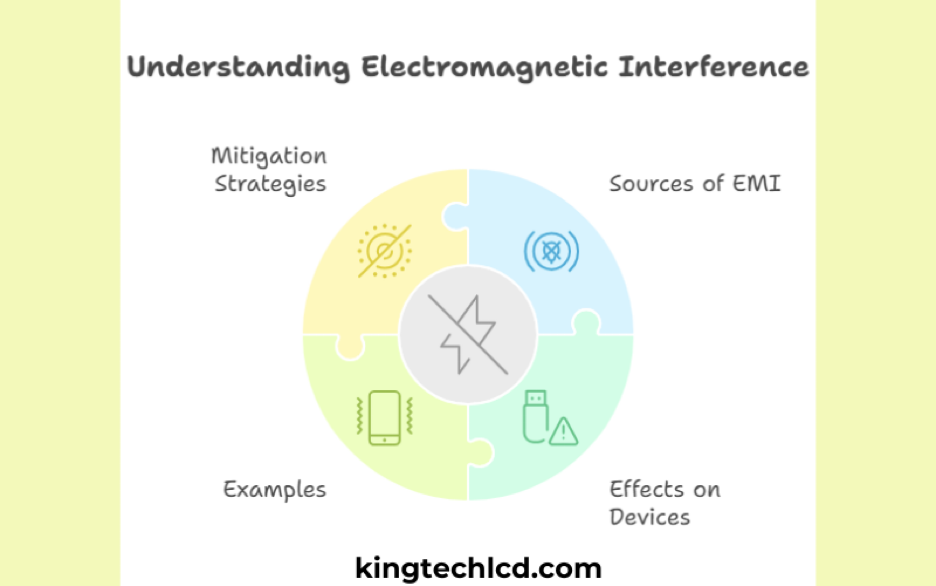Introductions: Electronic devices are everywhere in this interconnected digital world which has made our lives easy and enjoyable. But, these devices emit undesired electromagnetic energy during operation which is known as electromagnetic interference (EMI).
EMI is an influential downside of modern electronic and electrical devices that troubles the normal operation of various electronic and electrical devices. It also disrupts the operation of telecommunication and cellular systems.
Let’s explore what is electromagnetic interference, its sources, ways of mitigation, and more.

What is Electromagnetic Interference?
Electronic and electrical devices emit undesirable energy if not manufactured according to proper standards. This unwanted electromagnetic phenomenon is known as electromagnetic interference(EMI). The other name of EMI is radio frequency interference. EMI is common in electronic appliances used in telecommunication, aerospace, defense, and military.
It occurs when an electronic device runs close to the electromagnetic field and is disturbed by it. It breaks up the radio frequency spectrum.
EMI can have different properties based on the nature of the emitting device. It may occur naturally or as a result of human activity. It will not be found in a perfect electronic device; it is an undesirable signal at the receiver.
Electronic appliance manufacturers always try to minimize or prevent interference, because it affects the circuits of the device and can malfunction or stop them.
Example of EMI: Cell phone interference with audio equipment is a common example of electromagnetic interference. When a cell phone is placed near speakers or an audio amplifier, it can produce audible buzzing or clicking sounds. It occurs when the cell phone’s radio frequency signals induce unwanted currents in the audio equipment’s circuits.
Why is The Electromagnetic Interference Occurs?
The core basis of the EMI is the relationship between electricity and magnetism. In general, any electric current flow generates a magnetic field near it. Conversely, a changing magnetic field induces an electric current.
This interaction creates the basis of electromagnetic waves which can propagate through space and interfere with the electronic circuits. This interference can be exposed to noise, signal degradation, or severe damage.
Furthermore, inappropriate design and a lack of shielding of electronic devices can allow excessive EMI. It then interferes with other electronic devices and potentially leads to health and safety risks.
These are the basics of today’s context ‘what is electromagnetic interference’. Now let’s learn the various sources of EMI.
What Are The Sources of EMI?
EMI can be generated from different man-made and natural sources. The following are the natural sources from where electromagnetic interference usually emits.
Natural Sources of EMI:
Lightning: Lightning is a powerful natural source of EMI. It is a huge electrostatic discharge that occurs when an imbalance in electrical charges builds up within storm clouds or between clouds and the ground. This discharge releases enormous energy in a very short time.
A single lighting strike creates a very strong electromagnetic pulse that has a broad frequency spectrum from very low to high frequencies. This wide frequency range makes the lighting a significant source of broadband EMI.

Solar Flares and Solar Storms:
Solar flares and storms are significant sources of EMI. This EMI has the potential to disrupt many technological systems such as satellite and terrestrial communication on Earth.
Solar flares are sudden intense bursts of electromagnetic radiation from the Sun’s surface. They release energy from all electromagnetic spectrums including radio waves, X-rays, and gamma rays. This radiation reaches Earth at approximately eight minutes by traveling at the speed of light.
Solar storms are large expulsions of plasma and magnetic fields from the Sun’s corona due to the coronal mass ejections(CMEs).
CMEs can cause significant disturbances in Earth’s magnetic field known as geomagnetic storms. These storms induce electrical currents in long conductors, such as power lines and pipelines.
These geomagnetically induced currents(GICs) can damage or overload transformers in power grids, leading to widespread power outages, disrupt satellite navigation systems, such as GPS, and interfere with radio communications, particularly high-frequency (HF) radio.
Cosmic Radiation: Cosmic radiation consists of high-energy particles like protons, atomic nuclei, and electrons originating outside Earth’s atmosphere. These particles travel at extremely high speeds carrying enormous energy.
When these particles enter Earth’s atmosphere, they collide with atoms, creating a “shower” of secondary particles. After that, they ionize and create single event effects (SEEs) with electronic and microelectronic devices. This particularly happens in space-based systems and high-altitude electronics.
Human-Created EMI Sources:
There are many man-made sources of EMI available in the world. Here are a few of them.
Electronic Devices: Electronic devices are a common source of electromagnetic interference (EMI). Their abundance and complexity of internal circuits have made them a significant source of EMI. Switching circuits, clock signals, and data transmission effects all generate unwanted electromagnetic energy.
Rapidly switching currents, especially in power supplies and digital logic, create high-frequency transients that radiate EMI. Clock signals, which are essential for synchronizing digital devices, contain harmonics that generate electromagnetic emissions.
Furthermore, data transmission over cables or wireless networks generates electromagnetic fields. Poor design, inadequate shielding, and harmonic distortion from AC-powered devices amplify EMI.
For example, computers, mobile phones, household appliances, and LED lighting are the electronic devices that mostly emit EMI.

Power Lines and Electrical Equipment: Electromagnetic interference(EMI) from power lines and electrical equipment is a significant concern in industrial and residential settings. It occurs when electromagnetic energy disrupts the normal operation of electronic devices and communication systems. Power lines and electrical equipment generate EMI in several ways:
- Power Lines as a Source of EMI: Power transmission and distribution lines operate at low frequencies (50Hz or 60Hz), but they can still produce electromagnetic interference through electromagnetic fields (EMF), harmonic distortion, and switching transients.
- Electrical Equipment as a Source of EMI: Different electrical devices generate EMI including motors, generators, switch mode power supplies(SMPS), fluorescent and LED lighting, and industrial equipment.
Engineers use different methods to reduce EMI from power lines and electrical equipment such as shielding, filtering, grounding, and bonding. Twisted pair cables, shielded cables, and surge suppressors are also used to reduce EMI in power systems.

Radio and Television Transmitters: Radio and television transmitters are significant EMI generators. They generate and radiate electromagnetic waves to broadcast signals over long distances. These transmissions can interfere with other electronic devices, especially those sensitive to high-frequency signals.
The key factors contributing to EMI from radio and TV transmitters include:
EMI from TV and radio transmitters causes communication disruptions, audio and video disturbances, medical equipment malfunctions, and industrial and scientific equipment malfunction.
Filtering, shielding, power grounding, frequency coordination, low noise equipment use, and proper positioning of sensitive equipment can mitigate EMI from these transmitters.
Motors and Inductive Loads: EMI from motors and inductive loads primarily arises due to rapid switching, current variations, and electromagnetic field generation. They generate EMI through the following mechanism:
These EMI emissions can be mitigated using snubber circuits, ferrite beads, chokes, shielding and grounding, EMI filters, and soft switching techniques.
Cellular Networks and Wireless Communication: Cellular networks and wireless communication systems are significant sources of EMI due to their reliance on radio frequency (RF) signals for data transmission.
Cellular networks, Wi-Fi, Bluetooth, and other wireless technologies operate within specific frequency bands (e.g., 700 MHz – 6 GHz). These systems emit RF signals that can interfere with nearby electronic circuits.
EMI is generated as a radiated, conducted, and intermodulation signal in the cellular system. Cell towers, base stations, mobile phones, Wi-Fi routers, Bluetooth devices, and microwave links are the common sources of EMI in wireless communication.
Proper shielding, filtering, frequency management, and regulatory compliance can mitigate EMI from these sources.

Let’s have a look at some frequently asked questions related to what is electromagnetic interference.
- What is the electromagnetic interference standard?
Answer: The electromagnetic interference standard is the regulations and guidelines for specifying and controlling electromagnetic emissions from electronic and electrical devices. These standards ensure that devices do not interfere with the operation of the communication system around them or the electronic devices adjacent to them.
The major EMI standards are CISPR Standard, and FCC Part 15. EN standards, MIL STD-461, IEC standards, and ISO standards.
- How do you identify electromagnetic interference?
Answer: The easiest way to identify electromagnetic interference is by using a broadband RF field meter. This device measures the EMI of an area. It can find the source of electromagnetic interference and determine its severity.
- What are the effects of electromagnetic interference?
Answer: Electromagnetic interference has many effects on electrical and electronic systems. Some of the most common effects are:
- Q. What is the unit of electromagnetic interference?
Answer: The EMI unit is measured in terms of the strength of the electromagnetic field or by the power of the interfering signal. The EMI units are measured depending on the specific aspect of the source such as
Verdict: Electromagnetic interference (EMI) is an unavoidable occurrence in the modern world. EMI is present in various forms and intensities, from natural sources like lightning and solar flares to man-made sources.
Understanding “what is electromagnetic interference” and the sources and effects of it, will assist you to operate electronic systems perfectly and prevent potential disruptions or damage. Don’t stop here, stay connected with us to learn more.
